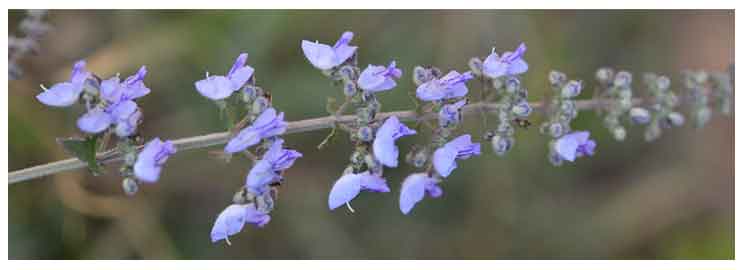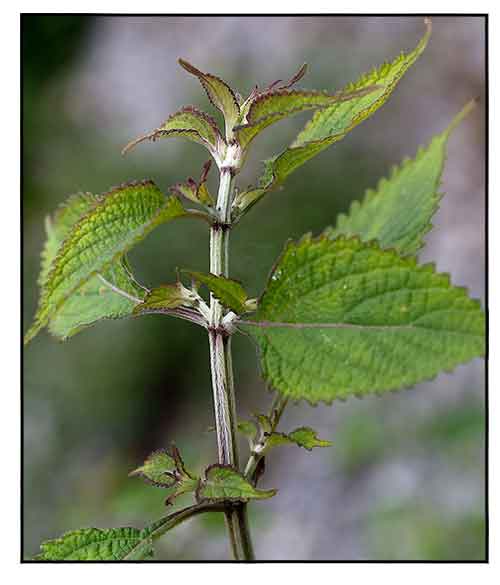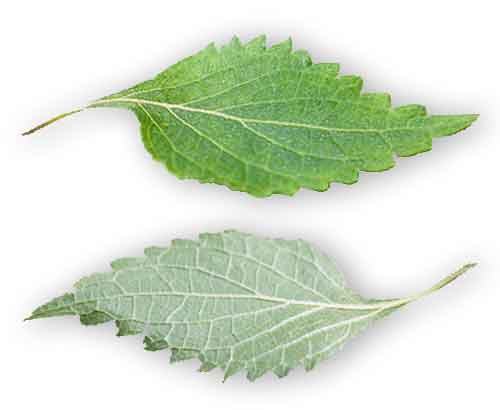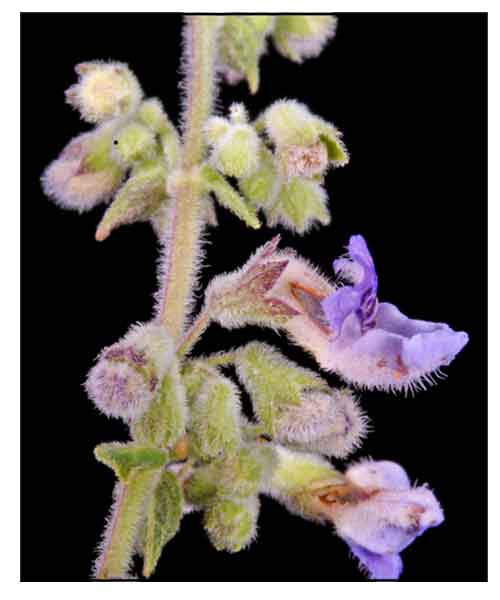 Gen info Gen info
- Isodon is a genus of flowering plants in the family Lamiaceae described in 1849. It is native to tropical and subtropical parts of the Old World, primarily Asia, with two species from Africa. POWO list includes 105 species.
- Taxonomy: The plant was initially classified as Rabdosia coetsa, but later transferred to the genus Isodon. The genus Isodon is a group of plants commonly known as "lungwort" or "netted veined Isodon". (4)
- Etymology: The genus name Isodon, established in 1840, derives from isos, meaning "equal", and odous, meaning "tooth", referring to the similarities in size and shape of the calyx teeth in many species within in the genus. The specific epithet coetsa derives from Chinese name cuo zi sha, referring to the plant's medicinal property.
 Botany Botany
• Blue Isodon is an erect, perennial, strongly aromatic undershrub, 0.5-2.5 m tall. It is a nectar plant for some butterfly species. Flowers are borne in panicles 5-15 cm long, narrow, at branch-ends or in leaf-axils, velvet-hairy. Flowers are purple to purple-blue, about 6 mm, velvet-hairy, tube about 2.5 mm, upper lip about 2.5 mm; lower lip broadly ovate, about 3.5 mm. Stamens do not protrude out. Style sometimes only slightly protrudes. Flower-stalks are 1-3 mm. Sepal-cup bell-shaped, about 1.5 x 1.5 mm, velvet-hairy outside, glandular, slightly 2-lipped; teeth ovate-triangular, about 1/3 as long as sepal-cup, tip pointed; fruiting sepal-cup tubular-bell-shaped, dilated to about 4 mm, slightly curved, netted at tip. Flower cymes are stalked, 3-5-flowered; lower floral leaves stalkless, ovate, upper floral leaves bractlike, ovate-lanceshaped, shorter than flower-stalks. Stem leaves are opposite; leaf-stalk 1-5.5 cm; leaf blade ovate, 3-9 x 1.5-6 cm, glandular, base broadly wedge-shaped, margin rounded toothed, tip tapering, lateral veins 3-paired. (Flowers of India)
 • Perennial aromatic herb, woody at base, 40-120 cm, Stems erect, widely branching, quadrangular, leafy, pubescent with short adpressed, retrorse, simple hairs or glabrescent. Leaves thin-textured, 4-10 x 2.5-6 cm, ovate to broadly ovate, acuminate, serrate, cuneate, with a sparse indumentum of very short eglandular simple hairs above and below and on lower surface densely gland-dotted; petiole up to 4 cm, somewhat winged. Cymes on short slender peduncles forming lateral and terminal racemes. Pedicels slender 1.5-2 mm, spreading-erect. Calyx in flower c. 2 mm, green or purplish with antrorse white hairs and sessile glands; teeth subequal, broad triangular; fruiting calyx c. 4 mm, obliquely campanulate, curved. Corolla pale violet or purplish, c. 6 mm; tube c. 3 mm long rather broad, clearly gibbous at base; lips diverging, lower cucullate entire clearly longer than upper shallowly lobed lip. Nutlets oblong, c. 1.2 x 0.8 mm, smooth, pale or dark brown, mucilaginous on wetting. (Flora of Pakistan) • Perennial aromatic herb, woody at base, 40-120 cm, Stems erect, widely branching, quadrangular, leafy, pubescent with short adpressed, retrorse, simple hairs or glabrescent. Leaves thin-textured, 4-10 x 2.5-6 cm, ovate to broadly ovate, acuminate, serrate, cuneate, with a sparse indumentum of very short eglandular simple hairs above and below and on lower surface densely gland-dotted; petiole up to 4 cm, somewhat winged. Cymes on short slender peduncles forming lateral and terminal racemes. Pedicels slender 1.5-2 mm, spreading-erect. Calyx in flower c. 2 mm, green or purplish with antrorse white hairs and sessile glands; teeth subequal, broad triangular; fruiting calyx c. 4 mm, obliquely campanulate, curved. Corolla pale violet or purplish, c. 6 mm; tube c. 3 mm long rather broad, clearly gibbous at base; lips diverging, lower cucullate entire clearly longer than upper shallowly lobed lip. Nutlets oblong, c. 1.2 x 0.8 mm, smooth, pale or dark brown, mucilaginous on wetting. (Flora of Pakistan)
Distribution
- Native to the
Philippines. (1) (2)
- In Benguet, Mountain Province.
- 1000-1400 m.
- Also native to Assam, Bangladesh, China South-Central, China Southeast, East Himalaya, India, Jawa, Laos, Lesser Sunda Is., Myanmar, Nepal, Sri Lanka, Sulawesi, Sumatera, Thailand, Tibet, Vietnam, West Himalaya. (1)
 Constituents Constituents
- GC-MS analysis of chloroform seed extract yielded octadecanoic acid, 2-(2hydroxyethoxy) ethyl ester (33.75%); dimethylsulfoxonium formylmethylide (21.40%); 9,12,15-octadecatrienoic acid (Z,Z,Z) (12.12 %); 12,15-octadecatrienoic acid, methyl ester, (Z,Z,Z) (7.17%); 9,12-octadecadienoic acid (Z,Z) (6.75%), and hexadecanoic acid, methyl ester (3.69%) as major chemical constituents. Methanolic extract of seeds was characterized with bicyclo[2.2.1]heptan- 2-one,1,7,7-trimethyl (49.93%); phenol,2-methoxy-3-(2-propenyl) (14.63 %); 9,12,15-octadecatrienoic acid, (Z,Z,Z)- (9.63%); caryophyllene oxide (2.57%), and caryophyllene (2.46%). (5)
- Quantitative phytochemical analysis of methanol extract of seeds revealed high amount of phenols (819.39 mg GAE/g), flavonoids (261.98 mg RUT/g), saponins (124.58 mg DIO/g), glycosides (729.23 mg DIG/g), terpenoids (181.69 mg LIN/g) and alkaloids (28.06%), alkaloid; total steroid content was higher in chloroform extract of seeds (444.71 mg CHO/g). (5)
- Study of aerial parts of Isodon coetsa isolated three new compounds (1-3), including a neolignan, a triterpenoid, and a diterpenoid, along with 20 known compounds (4-23).
(see study below) (8)
- Study of aerial parts isolated two new rearranged abietane diterpenoids, sincoetsin A (1) and sincoetsin B (2). (11)
Properties
- Isodon coetsa has bronze coloration in leaves. Bronze coloration in plant leaves has been identified as a good indicator to ascertain iron ore deposits. (8)
-
Studies suggest antimicrobial, antioxidant, anticancer, TNFα inhibitory, anti-inflammatory, cytotoxicity, C-mitotic, antibacterial properties.
Parts used
Roots, leaves, seeds.
Uses
Edibility
- No reports found on edibility for food consumption. Leaf and flower juice used for abdominal pain and toothache.
Folkloric
- No reported folkloric medicinal use in the Philippines.
- Used in traditional Chinese medicine as antibacterial, anti-inflammatory and antimtumor.
- Traditionally, root and leaf juices used for treatment of fever and gastrointestinal disorders.
- In Pakistan, leaf extracts used for treatment of blood pressure, heart disease, and kidney stones. (10) Juice of leaves and flowers taken orally for gastric and abdominal pains; also used for toothache. (14)
- In eastern Himalaya, leaves and shoots used to treat cuts and wounds. (15)
Others
- Nectar: A nectar plant of some butterfly species.
- Others: In Pakistan, plant used as forage and thatching; wood as fuel. (14)
Studies
• Antioxidant / Antimicrobial / Seeds: Study evaluated Isodon coetsa seeds for phytochemical content and biological activities. Results showed higher quantity of secondary metabolites in the methanolic extract of seeds. Antioxidant activity by DPPH analysis showed higher activity in ethyl acetate extract of seeds (94.58% scavenging at 40 µg/mL). The methanol extract of seeds showed higher antimicrobial potential followed by the chloroform extract of seeds against against tested bacteria and fungi by disc diffusion method, food poison method, and MIC. Results suggest good antioxidant and antimicrobial potential of seeds and potential as source of natural antioxidants and medicinally important phytocompounds for use in food and pharmaceutical industries. (5)
• Anticancer: Study evaluated the anticancer potential of I. coetsa using cytotoxic and cell viability assays. Allium cepa assay revealed cytotoxicity which increased with increasing concentrations and time durations. Evans blue staining of methanolic extract of A. cepa root stems showed dose dependent increase in activity, suggesting plant extract ability to induced cell death. Cell viability assay against ME treated with DLA and EAC cell lines revealed cytotoxicity which also increased with extract concentration. Results confirmed ability of I. coetsa to induce cell death in dividing cells, which is essential in anticancer therapy. (6)
• Inhibitory Effects on TNF-α: In inflammatory diseases, the expression of target protein TNF-α plays a crucial role in the pathogenesis and development of certain conditions, such as autoimmune diseases, rheumatoid arthritis, inflammatory bowel disease, and psoriatic arthritis. Study evaluated I. coetsa for compounds that exhibit inhibitory effects on TNF-α through computational methods as molecular docking and ADMET prediction. Among compounds binding to the active site of TNFα, five diterpenoids exhibited higher binding affinity than reference inhibitor SPD-304. Three compounds, 2α,3α,24-trihydroxy-11α,12α-epoxy-urs-20(30)-en-28,13β-olide, xerophilusin B, and 15α-hydroxy-6,7-seco-1α,7:11α,6-diolide-ent-kaur-16-en, they exhibited low toxicity and safety for oral administration. Study suggests the compounds have potential to replace inhibitor SPD-304 as important therapeutic agents against TNFα. (7)
• Cytotoxicity / Aerial Parts: Study of aerial parts of Isodon coetsa isolated three new compounds (1-3), including a neolignan, a triterpenoid, and a diterpenoid, along with 20 known compounds (4-23). Compounds 1, 3, 5-9, 11-13, 16-17, and 19-23 were evaluated for cytotoxicity against HT-29, BEL-7402, and SK-OV-3 human tumor cell lines. Compound 7 showed significant inhibitory effects against all three types of cells, with IC50s of 2.52, 3.06, and 2.14 µM, respectively. (8)
• Toxicological Evaluation of Polar and Non-Polar Components: Cytotoxic screening using Allium L. assay was done with extracts containing polar and nonpolar compounds as well as polar compounds alone. Extremely significant levels of chromosome abnormality (p<0.001) were observed with the extracts, but extract with polar and nonpolar compounds showed higher abnormality percentage. Not much variation was observed in the mitotic index. Studies showed many clastogenic and nonclastogenic abnormalities. Major abnormalities included chromosome fragments, stickiness, ring chromosomes, chromosome bridges, pulverization, binucleate cell, micronucleus, ball metaphase, chromosome laggards, and shift in microtubule organizing center. Results showed nonpolar components possessed more clastogenic activity, which can be specifically targeted to destroy cancer cells. Toxicity activity of extracts suggest the need of judicious use of I. coetsa in folk medicines. (9)
• C-Mitotic Effect: Study evaluated aqueous leaf extracts for cytotoxicity effect using Allium cepa assay. Root tips were treated with different extract concentrations (0.005 to 0.1%) for varying durations (1/2h to 3 h). Increase in mitotic index was observed in all treatments. C-mitotic effect was evidenced by by high frequency of aberrations viz., C-metaphase, polyploidy, cytostasis, and vagrant chromosones in the treated root tips. High duration treatments revealed decrease effect probably due to cytotoxic effect during prolonged exposure. Induction of polyploidy was observed at all treatments. Results suggest I. coetsa leaf extracts possess C-mitotic activity, which may be due to presence of a colchicene-like compound in it. (12)
• Silver Nanoparticles / Antibacterial / Leaves: Study reports on the environment-friendly synthesis of silver nanoparticles using Isodon coetsa acetone leaf extract. The AgNPs exhibited excellent anti-bacterial activity against Gram(+) and Gram(-) bacteria, higher in comparison to the crude extract. (13)
Availability
- Wild-crafted. |

![]()





 • Perennial aromatic herb, woody at base, 40-120 cm, Stems erect, widely branching, quadrangular, leafy, pubescent with short adpressed, retrorse, simple hairs or glabrescent. Leaves thin-textured, 4-10 x 2.5-6 cm, ovate to broadly ovate, acuminate, serrate, cuneate, with a sparse indumentum of very short eglandular simple hairs above and below and on lower surface densely gland-dotted; petiole up to 4 cm, somewhat winged. Cymes on short slender peduncles forming lateral and terminal racemes. Pedicels slender 1.5-2 mm, spreading-erect. Calyx in flower c. 2 mm, green or purplish with antrorse white hairs and sessile glands; teeth subequal, broad triangular; fruiting calyx c. 4 mm, obliquely campanulate, curved. Corolla pale violet or purplish, c. 6 mm; tube c. 3 mm long rather broad, clearly gibbous at base; lips diverging, lower cucullate entire clearly longer than upper shallowly lobed lip. Nutlets oblong, c. 1.2 x 0.8 mm, smooth, pale or dark brown, mucilaginous on wetting. (
• Perennial aromatic herb, woody at base, 40-120 cm, Stems erect, widely branching, quadrangular, leafy, pubescent with short adpressed, retrorse, simple hairs or glabrescent. Leaves thin-textured, 4-10 x 2.5-6 cm, ovate to broadly ovate, acuminate, serrate, cuneate, with a sparse indumentum of very short eglandular simple hairs above and below and on lower surface densely gland-dotted; petiole up to 4 cm, somewhat winged. Cymes on short slender peduncles forming lateral and terminal racemes. Pedicels slender 1.5-2 mm, spreading-erect. Calyx in flower c. 2 mm, green or purplish with antrorse white hairs and sessile glands; teeth subequal, broad triangular; fruiting calyx c. 4 mm, obliquely campanulate, curved. Corolla pale violet or purplish, c. 6 mm; tube c. 3 mm long rather broad, clearly gibbous at base; lips diverging, lower cucullate entire clearly longer than upper shallowly lobed lip. Nutlets oblong, c. 1.2 x 0.8 mm, smooth, pale or dark brown, mucilaginous on wetting. (
